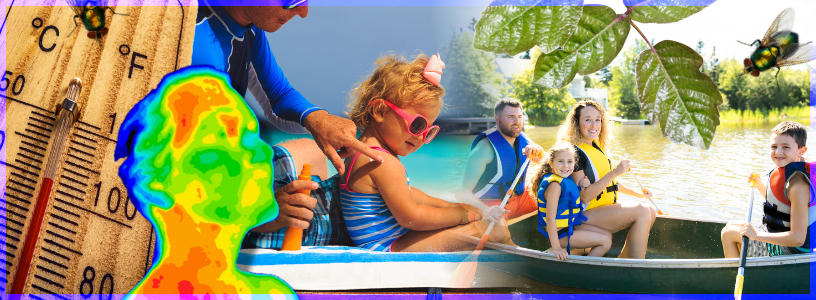SUMMER’S SEVEN: Outsmart These Avoidable Injuries
The most common health issues that doctors see on summer weekends can usually be prevented. (But accidents do happen, so remember to go to an urgent care clinic instead of the emergency room for non-emergencies: See our infographic for details.)
- Heat-related illness. Exposure to extreme heat can quickly lead to illness, organ failure and death. Never leave a child or older person in a parked car, use air conditioning to stay cool, and hydrate, hydrate, hydrate.
- Swimming injuries and drowning. Ten people die every day from unintentional drowning. Learn to swim, wear life jackets, and never swim alone.
- Burns and cuts. About a third of all injuries happen in the home. So, pay attention when using knives, store them safely, and use caution at the stove or grill, especially when children are present.
- Food poisoning. Stay healthy by keeping perishable food cold and use a thermometer to grill meat to the correct temperature.
- Sports injuries. Avoid muscle cramps, sprains, broken bones and concussions: stretch before the action, stay hydrated, and use protective equipment.
- Skin irritations and insect bites. An itchy rash or bug bite can quickly sideline summer fun. Use EPA-approved repellents, avoid bug-infested areas, and learn to identify poison ivy, oak and sumac.
- Sunburns. UV rays can damage your skin in as little as 15 minutes. Use a broad-spectrum sunscreen with at least SPF 15; apply it early and often, stay in the shade, and cover your skin.
Tips from Health Plans:
- Kaiser Permanente: Quick Tips: Staying Active in Hot Weather
- Providence: Keep Safe as You Savor Summer
- Regence: Sun Safety
BE WATER SMART: For Splashing Good Summer Fun
Every day, about 10 people die from unintentional drowning, 2 of them children under 14 years old. Drowning is the fifth leading cause of unintentional injury death for people of all ages, and the second leading cause of injury death for children.
Here’s how to keep children (and all ages) safe around pools, hot tubs, beaches, lakes and rivers:
- Be water competent. Click on the links below to find swim lessons for all ages near you. Children as young as six months old can learn aquatic safety with Infant Swimming Resource's Self-Rescue® program. Watch Bode and Morgan Miller’s heartfelt message about water safety awareness.
- Keep your eyes open. In the time it takes to reply to a text, check a fishing line, or apply sunscreen, someone can drown. Swim where a lifeguard is on duty or designate an adult to actively watch children. (And every good swimmer knows they should never swim alone, right?)
- Wear a life jacket on the water. The U.S. Coast Guard estimates that life jackets could have saved the lives of over 80% of boating fatality victims. Don’t stow your life jacket … in an accident it’s usually too late to put one on.
Additional Resources:
- American Red Cross: Find Swim Classes Near You
- Portland Parks and Recreation: Swimming Pools and Lessons
- Centers for Disease Control: Drowning Prevention
- Kaiser Permanente: Child Safety: Preventing Drowning
NEED HELP? SDTrust.com Helps You Get It Fast
Whenever you have a benefit question, go to the Health Trust website: sdtrust.com. You can probably find the answer yourself by going to your profile, where you’ll find links to help you zero in on your specific benefit coverage.
However, if you need to talk to a human being, here are three easy ways to get connected:
- Click on the contact icon the Health Trust website (it looks like a cartoon bubble in the upper right corner). Here’s where you’ll find the phone numbers and websites for all of the Trust’s benefit carriers, the Trust Administrative Office and PPS Human Resources Benefits Department, and the Bargaining Units who participate in the Trust.
- Register on your carrier’s website (Providence, Kaiser Permanente or Regence). This gives you access to secure messaging and other ways to contact your carrier’s service team … and you can also view your claims, deductible and other personal information.
- Call your carrier. The phone number is on your Health Plan ID card. Yep, the one you keep in your wallet!


